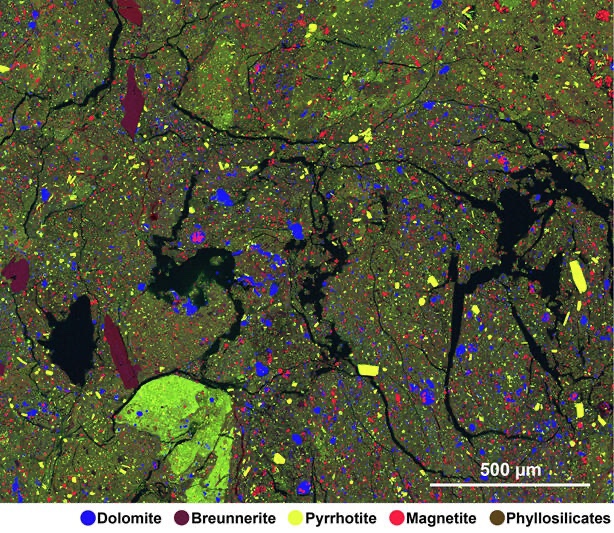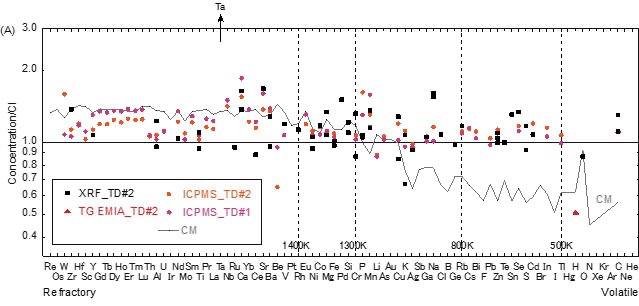

JAXA : はやぶさ2の論文を発表:
Publication de l’article Hayabusa2 :
Veröffentlichtes Hayabusa2-Papier:
Published Hayabusa2 paper:
已發表 Hayabusa2 論文:
ー初期分析化学分析の結果ー
宇宙航空研究開発機構(JAXA)
研究チームが、「小惑星リュウグウの水性変化と原始組成」を明らかにした。
2022年6月10日
北海道大学
東京工業大学
東北大学
京都大学
九州大学
広島大学
東京大学
はやぶさ2の初期分析:
小惑星リュウグウから回収したサンプル分析を実施中。
初期分析チームは「6つのサブチームと2つのェーズ2研究機関」で構成。
Okayama University
Japan Agency for Marine-Earth Science and Technology (JAMSTEC)
Kochi Institute for Core Sample Research.A summary of recent results from the Chemical Analysis Team in the Hayabusa2 Initial Analysis
Team has been published in the American scientific journal, “Science”, on June 10, 2022.
Initial analysis of the asteroid Ryugu sample
The sample from asteroid Ryugu returned to Earth by the asteroid explorer, Hayabusa2, on December 6, 2020,
initially underwent a cataloguing description (Phase-1 curation) at the facility established at JAXA’s Institute of Space and Astronautical Science.
Part of the returned sample was distributed to the Hayabusa2 Initial Analysis Team,
consisting of six sub-teams, and two Phase-2 curation institutes at Okayama University and JAMSTEC Kochi Institute for Core Sample Research.
The initial analysis
is designed to reveal the multifaceted features of the sample through a plan of high-precision analysis,with specialized sub-teams assigned to tackle the science objectives of the Hayabusa2 mission.
Meanwhile,
the Phase-2 curation institutes have specific specialtiesthat are utilized to catalogue the sample based on a comprehensive analysis flow,
and clarify the potential impact of the sample through measurement and analysis appropriate to the characteristics of the returned particles.
Reports from the six teams
involved in the initial analysis, as well as those from Okayama University and JAMSTEC Kochi Institute for Core Sample Research,will be announced separately as the results are published in scientific journals.
After the initial results have been released, a new overall summary of the Hayabusa2 science is planned.
https://global.jaxa.jp/press/2022/06/20220610-2_e.html
JAXA : Publication de l’article Hayabusa2 :
-Résultats de l’analyse initiale de chimie analytique-
Agence japonaise d’exploration aérospatiale (JAXA)
L’équipe de recherche a révélé “les changements aquatiques et la composition primitive de l’astéroïde Ryugu”.
10 juin 2022
Université d’Hokkaidō
Institut de technologie de Tokyo
Université du Tohoku
Université de Kyoto
Université de Kyūshū
Université d’Hiroshima
Université de Tokyo
Analyse initiale de Hayabusa2 :
Nous effectuons des analyses d’échantillons prélevés sur l’astéroïde Ryugu.
L’équipe d’analyse initiale est composée de “6 sous-équipes et 2 instituts de recherche Az 2”.
JAXA: Veröffentlichtes Hayabusa2-Papier:
-Ergebnisse der ersten analytisch-chemischen Analyse-
Japanische Agentur für Luft- und Raumfahrtforschung (JAXA)
Das Forschungsteam enthüllte “Aquatische Veränderungen und primitive Zusammensetzung des Asteroiden Ryugu”.
10. Juni 2022
Hokkaido-Universität
Technisches Institut Tokio
Tohoku-Universität
Universität Kyoto
Kyushu-Universität
Universität Hiroshima
Universität Tokio
Erste Analyse von Hayabusa2:
Wir führen Probenanalysen durch, die vom Asteroiden Ryugu gesammelt wurden.
Das Erstanalyseteam besteht aus „6 Teilteams und 2 Az 2 Forschungsinstituten“.
Samples returned from the asteroid Ryugu are similar to Ivuna-type carbonaceous meteorites
Abstract
Carbonaceous meteorites
are thought to be fragments of C-type (carbonaceous) asteroids.Samples of the C-type asteroid (162173) Ryugu were retrieved by the Hayabusa2 spacecraft.
We measure the mineralogy,
bulk chemical and isotopic compositions of Ryugu samples.They are mainly composed of materials similar to carbonaceous chondrite meteorites, particularly the CI (Ivuna-type) group.
The samples consist predominantly of minerals formed in aqueous fluid on a parent planetesimal.
The primary minerals
were altered by fluids at a temperature of 37 ± 10°C, 5.2+0.7−0.8 5.2 − 0.8 + 0.7 (Stat.) +1.6−2.1 − 2.1 + 1.6 (Syst.) million years after formation of the first solids in the Solar System.After aqueous alteration,
the Ryugu samples were likely never heated above ~100°C.The samples have a chemical composition that more closely resembles the Sun’s photosphere than other natural samples do.